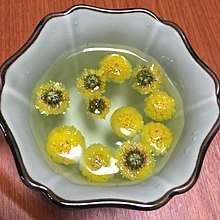Chrysanthemum tea
|
| |
| Type | Tea |
|---|---|
| Country of origin | East Asia |
| Colour | clear to pale yellow |
| Ingredients | dried chrysanthemum, hot water |
| Regional names | |||||||||||||||||||
| Chinese name | |||||||||||||||||||
|---|---|---|---|---|---|---|---|---|---|---|---|---|---|---|---|---|---|---|---|
| Chinese | 菊花茶 | ||||||||||||||||||
| |||||||||||||||||||
| Vietnamese name | |||||||||||||||||||
| Vietnamese | trà bông cúc | ||||||||||||||||||
| Thai name | |||||||||||||||||||
| Thai | น้ำเก๊กฮวย | ||||||||||||||||||
| RTGS | nam kekhuai | ||||||||||||||||||
| Korean name | |||||||||||||||||||
| Hangul | 국화차 | ||||||||||||||||||
| Hanja | 菊花茶 | ||||||||||||||||||
| |||||||||||||||||||
| Malay name | |||||||||||||||||||
| Malay | teh krisantimum | ||||||||||||||||||
| Tamil name | |||||||||||||||||||
| Tamil | saamandhi | ||||||||||||||||||
Chrysanthemum tea is a flower-based infusion beverage made from chrysanthemum flowers of the species Chrysanthemum morifolium or Chrysanthemum indicum, which are most popular in East Asia, especially China. To prepare the tea, chrysanthemum flowers (usually dried) are steeped in hot water (usually 90 to 95 degrees Celsius after cooling from a boil) in either a teapot, cup, or glass; often rock sugar or cane sugar is also added, and occasionally also wolfberries. The resulting drink is transparent and ranges from pale to bright yellow in color, with a floral aroma. In Chinese tradition, once a pot of chrysanthemum tea has been drunk, hot water is typically added again to the flowers in the pot (producing a tea that is slightly less strong); this process is often repeated several times. Chrysanthemum tea was first drunk during the Song Dynasty (960–1279).[1]
Varieties
China
Several varieties of chrysanthemum, ranging from white to pale or bright yellow in color, are used for tea. These include:
- Huángshān-gòngjú (黄山贡菊, literally "Yellow Mountain tribute chrysanthemum"); also called simply gòngjú (贡菊)
- Hángbáijú (杭白菊), originating from Tongxiang, near Hangzhou; also called simply Hángjú, (杭菊)
- Chújú (滁菊), originating from the Chuzhou district of Anhui
- Bójú (亳菊), originating in the Bozhou district of Anhui
Of these, the first two are most popular. Some varieties feature a prominent yellow flower head while others do not.
Korea

Gukhwacha (국화차; 菊花茶) is made from dried Indian chrysanthemum collected before fully opened.
- Chrysanthemum tea – The flowers are blanched in bamboo salt water, carefully washed in cold water and drained on kitchen towel. The drained flowers are covered with hanji and dried in an ondol (floor-heated) room. When served, three to four flowers are added to hot water.
- Honey chrysanthemum tea – The flowers are carefully washed and dried, then preserved in honey for three to four weeks. When served, the preserved flowers are added to hot water.
- Medicinal chrysanthemum tea – The flowers are washed carefully, steamed using the water mixed with herbal decoction and dried. When fully dried, they are steamed again, and dried again. This process is repeated nine times. Water to decoction ratio can be 8:1, and the decoction is usually made of dried roots of white woodland peony, steamed and dried roots of rehmannia, dried roots of Korean angelica, and dried roots of lovage.
Medicinal use

Chrysanthemum tea has many purported medicinal uses, including an aid in recovery from influenza, acne and as a "cooling" herb. According to traditional Chinese medicine the tea can aid in the prevention of sore throat and promote the reduction of fever. In Korea, it is known well for its medicinal use for making people more alert and is often used as a pick-me-up to render the drinker more awake. In western herbal medicine, Chrysanthemum tea is drunk or used as a compress to treat circulatory disorders such as varicose veins and atherosclerosis.
In traditional Chinese medicine, chrysanthemum tea is also said to clear the liver and the eyes. It is believed to be effective in treating eye pain associated with stress or yin/fluid deficiency. It is also used to treat blurring, spots in front of the eyes, diminished vision, and dizziness.[2]
Commercial availability
Although typically prepared at home, chrysanthemum tea is also available as a beverage in many Asian restaurants (particularly Chinese ones), and is also available from various drinks outlets in East Asia as well as Asian grocery stores outside Asia in canned or packed form, be it in whole in grain or teabag presentation. Due to its medicinal value, it may also be available at health food stores or Traditional Chinese medicine outlets, often mixed with other ingredients. Chrysanthemum tea has also recently been made available in many non-Asian grocery stores in the New England area of the United States. It's typically sold in a RTD (ready-to-drink) form as an iced tea.[3]
See also
- Chinese herb tea
- List of Chinese teas
- Traditional Korean tea
- Xia Sang Ju
-
.svg.png) Drink portal
Drink portal -
 China portal
China portal
References
- ↑ Campbell, Dawn L. (1995). The tea book. Gretna: Pelican Publishing. p. 116. ISBN 978-1-56554-074-3.
- ↑ "Archived copy". Archived from the original on 2009-02-21. Retrieved 2009-02-28.
- ↑ Nichols, Lei. "Wise Mouth Tea". wise_mouth. Instagram.
.jpg)